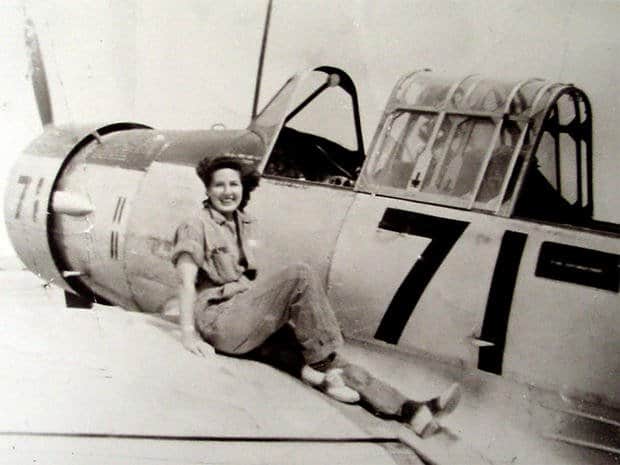 Lucile Doll Wise
Lucile Doll Wise
August 1, 1920 – August 2, 2018
Class W-43-7
Planes flown: AT-11, B-25, C-45, C-60, UC-78
Assigned bases:
Asheville Weather Wing HQ, (AACS) (N.C.)
Kansas City, 23rd Weather Region HQ (Kan.)
“Jacqueline Cochran was looking for WASP. They told me I would have to be interviewed and they would contact me when they came to the Wichita area. But I didn’t wait for that. I went down to Houston for my interview, to speed things up. And I think that’s one of the smartest things I did.”
~WASP Lucile Doll Wise
Lucile was born August 1, 1920 in Larned, Kansas, the daughter of Fred and Edna Barstow Doll. She was a graduate of Larned High School in 1938, and the Colorado Woman’s College in Denver Colorado in 1940.
She learned to fly in Wichita, KS and was accepted for training as a WASP pilot in May, 1943. She was among the first women pilots in history to fly military aircraft.
“We were trained the military way, just like the male cadets were trained,” said Wise. “We lived in barracks, we slept on metal cots, and we learned to march, and we were under military discipline, under demerits — we had to make our beds a certain way, and we had inspections. It was very stressful because we had to meet the requirements.”
Wise said the women proved they could fly those planes just as well as the men could, “and we were really proud women.”
The WASPs proved themselves again and again, logging more than 60 million miles in more than 12,000 aircraft: the B-17s, B-24s, and P-51 Mustangs that helped win the war.
But while other women involved in the war effort — the “Rosie the Riveters” and their like — lived on in our popular culture, after the war the WASPs were largely forgotten.
“I think every American should be aware of what these women sacrificed and did during World War II,” said filmmaker Jill Bond. “It was during a time when women were not able to have careers and do things outside of their traditional roles, and this was an opportunity to be adventurous, to serve their country, and they did it in such a graceful and beautiful way.”
After training, Wise was assigned to the Army Air Forces Weather Wing in Ashville, NC and later in Kansas City, MO, and served until the WASP were disbanded in December of 1944.
On September 5, 1950 she married Robert W. Wise and resided in Alexandria, VA until 1982, when she returned to Larned.
She volunteered in the WASP office in Washington, DC in 1977, working on lobbying efforts to obtain military recognition and Veteran’s benefits for WASP members. Within the WASP organization, she served in numerous roles including Regional Director, By-Laws Chair, Scholarship Chair, and President.
Lucile was a member of the Presbyterian Church and was a member of a number of groups including the Colorado Aviation Historical Society, the Women Military Aviators Association, and Women in Aviation, International. She was active in community and church affairs, and served as a volunteer archivist and docent for several years at the Santa Fe Trail Center in Larned.
While none of the WASPs saw combat, flying fast, powerful war machines was dangerous business. Thirty-eight women died in crashes. And since the women were classified as civilians, neither they nor their families received military benefits.
“If a girl got killed, her parents didn’t get anything, not even a flag – nothing. Not even any acknowledgement that their daughter had been in the military.”
All that changed in 1976, when — with great fanfare — women were admitted into the Air Force. The WASP took notice.
“They were putting out news releases that for the first time women would be flying military aircraft, and they had just kind of forgotten about us,” said Wise. “And that’s when we got organized.”
They got organized . . . and got results. In 1977 the WASP were re-classified as military veterans and granted full benefits.
But for Lucille Wise and the others, real recognition came in 2009, when President Obama signed a bill awarding the WASP the Congressional Gold Medal.
“Simply put, the outstanding success that America achieved in the air during World War II would not have been possible without the Women Airforce Service Pilots,” House Speaker John Boehner said at a Washington ceremony the following year.
Deanie Parrish accepted the award for all the WASP: “I believe this is the day that when the people of America will no longer hesitate in answering the question, ‘Do you know who the WASP were?'”
Today, more than 60,000 women serve in the U.S. Air Force, flying on the wings of a legacy that was almost left behind.
“Those women give you the credit for opening the door for them,” said Riggs.
“They do, yes,” said Wise. “If we had any part in it, I am very pleased. They probably would have done it without us, but maybe we made it a little bit easier for them.”

Sources:
CBS news
Texas Womens University
WASP Final Flight





